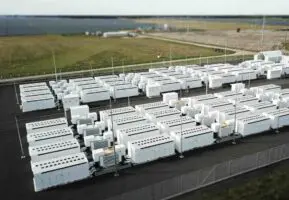Germany, Japan, and the US are regarded as the leaders in grid-level energy storage – due to the combination of government mandates and the need to incorporate large amounts of built and planned solar and wind farms.
It is Australia, though, that is widely considered to be the testing ground for storage, both behind the meter and on the network, and the country that will define how storage is more widely implemented. That’s largely due to its huge rates of penetration of rooftop solar, which is driving both challenges and opportunities for grid operators, retailers and consumers alike.
“It is one of the best organic markets in the world,” said Hugh Bromley, an analyst from Bloomberg New Energy Finance – which also explains the huge amount of interest at the Australian Solar and Energy Storage conference in Melbourne this week, where Bromley made these comments.
Bromley also put another fascinating aspect to that equation. Australia, he says, has the cheapest price of solar in the world, on a whole bunch of metrics -in terms of income, months of savings, and percentage of property value.
Rather than feeding it back into the grid at next to nothing, that drives a huge incentive to protect the value of that cheap solar (and duck expensive fossil fuel power from the grid) with battery storage.
It’s ironic that Australia has such cheap solar, given the cost of delivery of our so-called “cheap coal”. The arrival of competitive battery storage will just increase the prospect of the centralised generators becoming stranded assets.
While Tesla has dominated the headlines in the past three weeks following its big announcement on battery storage, it is clear that its rivals are also moving quickly. They will need to, to match it on costs.
Tesla, it is agreed, has changed the conversation around battery storage. Consumers want it, competitors and retailers are going to have to move quickly to meet that demand, and Australia is being regarded as the market where it could all happen.
“Australia is going to be the testing ground for the world,” says Raghu Belur, co-founder and head of products and strategic initiatives at US smart energy company Enphase.
“It is a perfect environment for storage. We will learn so much here about all the challenges and opportunities that all other energy economies will face.”
Enphase’s head of storage, Greg Wolfson, says storage means that the more renewable energy you put on the grid, the more reliable it is. Distribution feeders are more robust, and the power quality is increased. Everyone benefits.
So much so that Enphase has chosen Australia to be the launch-pad, early next year, for its new battery storage offering – a 1.2kWh system that it will integrate with its micro-inverters and other smart technology.
The 1.2kWh size is much reduced from the 5kWh – 10kWh units being offered in the residential market by other companies, but Enphase is taking the same approach that led it to focus on micro-inverters, rather than larger units.
The key, though, is in the smarts. Australia has built a huge, largely dumb grid, in that it is geared pretty much for one directional flow of energy. The worst thing that can happen, Belur says, is to add dumb solar.
Belur says it is clear that the future is distributed energy, rather than centralised generation. But that means there is even more need for smart technology.
“If you put dumb solar out there it will turn into a liability,” Belur says. “The grid is not designed for reverse power flow. We need to add storage, but let’s not add dumb storage. It needs to be fully adaptive, and fully controllable.”
Enphase’s head of storage, Greg Wolfson, says storage means that the more renewable energy you put on the grid, the more reliable it is. Distribution feeders are more robust, and the power quality is increased. Everyone benefits.
Enphase has already used its smarts – micro inverters based around sophisticated communications and software – to address crippling issues in the Hawaii grid, which has a huge penetration of solar, and is now heading towards a 100 per cent renewable energy grid.
The key, says Enphase, is in the data. Enphase collects and manages a terrabyte of data each day. “We transact more than Twitter on a daily basis,” claims Belur. You can see the animation from its micro-inverters on this page (just drill down to find your local area and the performance of the installed modules and inverters, click on view public systems).
Australia is not the only market to be immediately attractive for mass deployment of battery storage in homes and businesses. Germany is identified along with Australia – by Tesla and Australia’s flow battery developer Redflow – as the other major market.
In the last two years, about 10,000 systems have been installed in German homes and businesses under a program sponsored by its development bank kFw.
In Australia, however, Enphase thinks the market – without subsidies – can be much bigger.
By 2020, it predicts, Australia could host some 1,000MWh of battery storage at the residential level. If the average home installs 10kWh, that makes some 100,000 homes. Many homes may install less, depending on the consumption patters and the size of their solar array.
In particular, Wolfson points to those households who currently receive high feed-in tariffs – 60c/kWh or more in NSW – but who will get less than 6c/kWh, or possibly nothing, when the scheme ends in 2016.
“They have a serious problem, Wolfson says. “Storage is a solution for them.”
It is this market that most battery storage companies are targeting, although there is great debate about how much value can be delivered, depending as it does on the size of systems and the household’s consumption.
(It should be noted that households in Queensland and South Australia, who have high export tariffs locked in for another decade or more, would have no economic drive for battery storage. This is also the case in most states of the US.)
Wolfson also says there is too much talk on the hardware of battery storage, and particularly on its chemistry, and not enough on its smarts.
“Just sticking storage in the garage is not going to do anything. You need the communications,” he says.
And this will become increasingly important as the share of solar grows from 1 per cent of the world’s electricity mix now (2.5 per cent in Australia) to 20, 30 or even 50 per cent.











